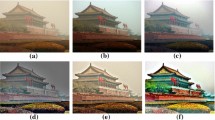Abstract
The air pollution and foggy weather often result in serious distortion while taking photos or recognizing patterns. He et al. have introduced the dark channel prior to solve this dehazing problem. Unfortunately, it cannot function well once the color difference of target image is large. More precisely, the dehazed result looks unnatural. Thus, we aim to develop a brand-new visibility dehazing technique based on the channel-weighted analysis and illumination tuning. The channel-weighted analysis is adopted to eliminate the unnatural effect, while the illumination tuning is applied to refine the details. Simulation results have demonstrated that the new method can guarantee the readability of a hazed image after removing noise, including the foggy photo and sandstorm one.























Similar content being viewed by others
References
Berman D, Treibitz T, Avidan S (2016) Non-local image dehazing, Proceedings of IEEE Conference on Computer Vision and Pattern Recognition (CVPR), pp. 1674–1682
Berman D, Treibitz T, Avidan S (2017) Air-light estimation using haze-lines, Proceedings of IEEE Conference on Computational Photography (ICCP), pp.1–9, May
He KM, Sun J, Tang X (2011) Single image haze removal using dark channel prior. IEEE Trans Pattern Anal Mach Intell 33(12):2341–2353
Huang SC, Chen BH, Wang WJ (2014) Visibility restoration of single hazy images captured in real-world weather. IEEE Transactions on Circuits and System for Video Technology 24(10):1814–1824
Huang Y, Yao H, Zhao S, Zhang Y (2017) Towards more efficient and flexible face image deblurring using robust salient face landmark detection. Multimedia Tools and Applications 76(1):123–142
Jegou H, Douze M, Schmid C (2008) Hamming embedding and weak geometric consistency for large scale image search, Proceedings of 10th European Conference on Computer, pp. 304–317
Jian M, Dong J, Lam KM (2013) FSAM: a fast self-adaptive method for correcting non-uniform illumination for 3D reconstruction. Comput Ind 64(9):1229–1236
Jian M, Lam KM, Dong J (2014) Illumination-insensitive texture discrimination based on illumination compensation and enhancement. Comput Ind 269:60–72
Jian M, Yin Y, Dong J, Zhang W (2018) Comprehensive assessment of non-uniform illumination for 3D heightmap reconstruction in outdoor environments. Comput Ind 99:110–118
Jiang X, Yao H, Zhao S (2017) Text image deblurring via two-tone prior. Neurocomputing 242:1–14
Kopf J, Neubert B, Chen B, Cohen M, Or DC, Deussen O, Uyttendaele M, Lischinski D (2008) Deep photo: Model-based photograph enhancement and viewing, ACM Transactions on Graphics (TOG), 27(5), Article 116
Meng GF, Wang Y, Duan J, Xiang S, and Pan C (2013) Efficient image dehazing with boundary constraint and contextual regularization, Proceedings of IEEE International Conference on Computer Vision (ICCV), pp. 617–624
Narasimhan SG, Nayar SK (2001) Removing weather effects from monochrome images. Proceedings of IEEE Conference on Computer Vision and Pattern Recognition (CVPR) 2:186–193
Narasimhan SG, Nayar SK (2003) Interactive (De) weathering of an image using physical models, IEEE Workshop on Color and Photometric Methods in Computer Vision (ICCV), pp. 1387–1394
Narasimhan SG, Nayar SK (2003) Contrast restoration of weather degraded images. IEEE Trans Pattern Anal Mach Intell 25(6):713–724
Schechner YY, Narasimhan SG, Nayar SK (2003) Polarization based vision through haze. Appl Opt 42(3):511–525
Tan R (2008) Visibility in bad weather from a single image, Proceedings of IEEE Conference on Computer Vision and Pattern Recognition (CVPR), pp. 1–8
Tan K, Oakley JP (2000) Enhancement of color images in poor visibility conditions. Proceedings of IEEE International Conference on Signal Processing (ICIP) 2:788–791
Zhu M, He B, Wu Q (2018) Single image dehazing based on dark channel prior and energy minimization. IEEE Signal Processing Letters 25(2):174–178
Author information
Authors and Affiliations
Corresponding author
Additional information
Publisher’s Note
Springer Nature remains neutral with regard to jurisdictional claims in published maps and institutional affiliations.
Rights and permissions
About this article
Cite this article
Lee, JS., Li, CH. & Lee, HY. Visibility dehazing based on channel-weighted analysis and illumination tuning. Multimed Tools Appl 78, 1831–1856 (2019). https://doi.org/10.1007/s11042-018-6280-2
Received:
Revised:
Accepted:
Published:
Issue Date:
DOI: https://doi.org/10.1007/s11042-018-6280-2



